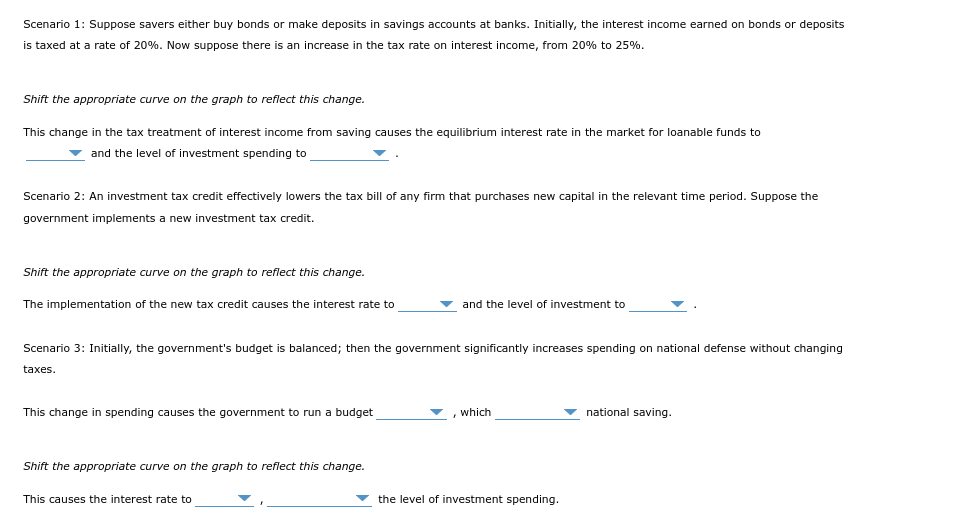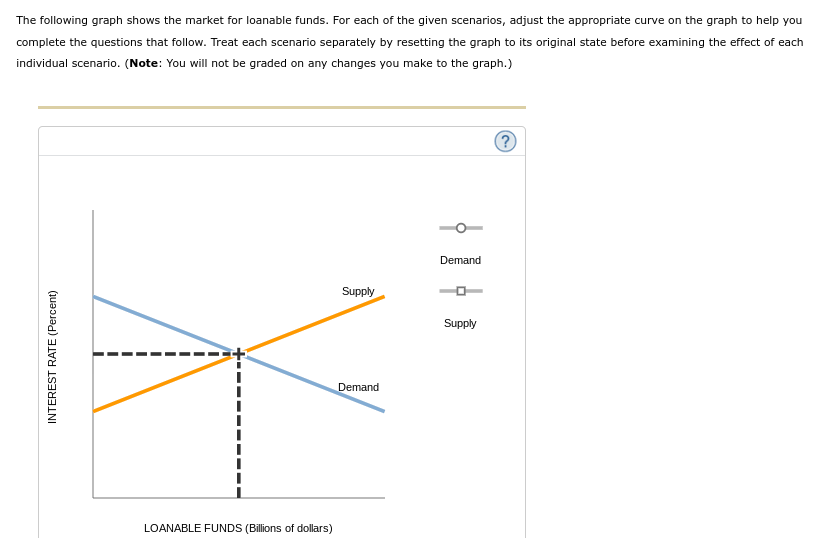The following graph shows the market for loanable funds. For each of the given scenarios, adjust the appropriate curve on the graph to help you complete the questions that follow. Treat each scenario separately by resetting the graph to its original state before examining the effect of each individual scenario. (graph in image) Scenario 1: Suppose savers either buy bonds or make deposits in savings accounts at banks. Initially, the interest income earned on bonds or deposits is taxed at a rate of 20%. Now suppose there is an increase in the tax rate on interest income, from 20% to 25%. Shift the appropriate curve on the graph to reflect this change. This change in the tax treatment of interest income from saving causes the equilibrium interest rate in the market for loanable funds to (a. fall, b. rise) and the level of investment spending to (a. increase, b. decrease). Scenario 2: An investment tax credit effectively lowers the tax bill of any firm that purchases new capital in the relevant time period. Suppose the government implements a new investment tax credit. Shift the appropriate curve on the graph to reflect this change. The implementation of the new tax credit causes the interest rate to (a. fall, b. rise) and the level of investment to (a. fall, rise). Scenario 3: Initially, the government's budget is balanced; then the government significantly increases spending on national defense without changing taxes. This change in spending causes the government to run a budget (a. deficit, b.surplus) , which (a. increases, b. decreases) national saving. Shift the appropriate curve on the graph to reflect this change. This causes the interest rate to (a. fall, b. rise), (a. crowding out, b. increasing) the level of investment spending
The following graph shows the market for loanable funds. For each of the given scenarios, adjust the appropriate curve on the graph to help you complete the questions that follow. Treat each scenario separately by resetting the graph to its original state before examining the effect of each individual scenario. (graph in image) Scenario 1: Suppose savers either buy bonds or make deposits in savings accounts at banks. Initially, the interest income earned on bonds or deposits is taxed at a rate of 20%. Now suppose there is an increase in the tax rate on interest income, from 20% to 25%. Shift the appropriate curve on the graph to reflect this change. This change in the tax treatment of interest income from saving causes the equilibrium interest rate in the market for loanable funds to (a. fall, b. rise) and the level of investment spending to (a. increase, b. decrease). Scenario 2: An investment tax credit effectively lowers the tax bill of any firm that purchases new capital in the relevant time period. Suppose the government implements a new investment tax credit. Shift the appropriate curve on the graph to reflect this change. The implementation of the new tax credit causes the interest rate to (a. fall, b. rise) and the level of investment to (a. fall, rise). Scenario 3: Initially, the government's budget is balanced; then the government significantly increases spending on national defense without changing taxes. This change in spending causes the government to run a budget (a. deficit, b.surplus) , which (a. increases, b. decreases) national saving. Shift the appropriate curve on the graph to reflect this change. This causes the interest rate to (a. fall, b. rise), (a. crowding out, b. increasing) the level of investment spending
Microeconomics: Private and Public Choice (MindTap Course List)
16th Edition
ISBN:9781305506893
Author:James D. Gwartney, Richard L. Stroup, Russell S. Sobel, David A. Macpherson
Publisher:James D. Gwartney, Richard L. Stroup, Russell S. Sobel, David A. Macpherson
Chapter7: Consumer Choice And Elasticity
Section: Chapter Questions
Problem 6CQ
Related questions
Question
The following graph shows the market for loanable funds. For each of the given scenarios, adjust the appropriate curve on the graph to help you complete the questions that follow. Treat each scenario separately by resetting the graph to its original state before examining the effect of each individual scenario.
(graph in image)
Scenario 1: Suppose savers either buy bonds or make deposits in savings accounts at banks. Initially, the interest income earned on bonds or deposits is taxed at a rate of 20%. Now suppose there is an increase in the tax rate on interest income, from 20% to 25%.
Shift the appropriate curve on the graph to reflect this change.
This change in the tax treatment of interest income from saving causes the equilibrium interest rate in the market for loanable funds to (a. fall, b. rise) and the level of investment spending to (a. increase, b. decrease).
Scenario 2: An investment tax credit effectively lowers the tax bill of any firm that purchases new capital in the relevant time period. Suppose the government implements a new investment tax credit.
Shift the appropriate curve on the graph to reflect this change.
The implementation of the new tax credit causes the interest rate to (a. fall, b. rise) and the level of investment to (a. fall, rise).
Scenario 3: Initially, the government's budget is balanced; then the government significantly increases spending on national defense without changing taxes.
This change in spending causes the government to run a budget (a. deficit, b.surplus) , which (a. increases, b. decreases) national saving.
Shift the appropriate curve on the graph to reflect this change.
This causes the interest rate to (a. fall, b. rise), (a. crowding out, b. increasing) the level of investment spending.

Transcribed Image Text:Scenario 1: Suppose savers either buy bonds or make deposits in savings accounts at banks. Initially, the interest income earned on bonds or deposits
is taxed at a rate of 20%. Now suppose there is an increase in the tax rate on interest income, from 20% to 25%.
Shift the appropriate curve on the graph to reflect this change.
This change
the tax treatment of interest income from saving causes the equilibrium interest rate in the market for loanable funds to
and the level of investment spending to
Scenario 2: An investment tax credit effectively lowers the tax bill of any firm that purchases new capital in the relevant time period. Suppose the
government implements a new investment tax credit.
Shift the appropriate curve on the graph to reflect this change.
The implementation of the new tax credit causes the interest rate to
Scenario 3: Initially, the government's budget balanced; then the government significantly increases spending on national defense without changing
taxes.
This change in spending causes the government to run budget
Shift the appropriate curve on the graph to reflect this change.
and the level of investment to
This causes the interest rate to
, which
▼ the level of investment spending.
national saving.

Transcribed Image Text:The following graph shows the market for loanable funds. For each of the given scenarios, adjust the appropriate curve on the graph to help you
complete the questions that follow. Treat each scenario separately by resetting the graph to its original state before examining the effect of each
individual scenario. (Note: You will not be graded on any changes you make to the graph.)
INTEREST RATE (Percent)
LOANABLE FUNDS (Billions of dollars)
Supply
Demand
Demand
Supply
?
Expert Solution
This question has been solved!
Explore an expertly crafted, step-by-step solution for a thorough understanding of key concepts.
This is a popular solution!
Trending now
This is a popular solution!
Step by step
Solved in 4 steps with 3 images

Knowledge Booster
Learn more about
Need a deep-dive on the concept behind this application? Look no further. Learn more about this topic, economics and related others by exploring similar questions and additional content below.Recommended textbooks for you

Microeconomics: Private and Public Choice (MindTa…
Economics
ISBN:
9781305506893
Author:
James D. Gwartney, Richard L. Stroup, Russell S. Sobel, David A. Macpherson
Publisher:
Cengage Learning

Economics: Private and Public Choice (MindTap Cou…
Economics
ISBN:
9781305506725
Author:
James D. Gwartney, Richard L. Stroup, Russell S. Sobel, David A. Macpherson
Publisher:
Cengage Learning

Exploring Economics
Economics
ISBN:
9781544336329
Author:
Robert L. Sexton
Publisher:
SAGE Publications, Inc

Microeconomics: Private and Public Choice (MindTa…
Economics
ISBN:
9781305506893
Author:
James D. Gwartney, Richard L. Stroup, Russell S. Sobel, David A. Macpherson
Publisher:
Cengage Learning

Economics: Private and Public Choice (MindTap Cou…
Economics
ISBN:
9781305506725
Author:
James D. Gwartney, Richard L. Stroup, Russell S. Sobel, David A. Macpherson
Publisher:
Cengage Learning

Exploring Economics
Economics
ISBN:
9781544336329
Author:
Robert L. Sexton
Publisher:
SAGE Publications, Inc

Macroeconomics: Private and Public Choice (MindTa…
Economics
ISBN:
9781305506756
Author:
James D. Gwartney, Richard L. Stroup, Russell S. Sobel, David A. Macpherson
Publisher:
Cengage Learning